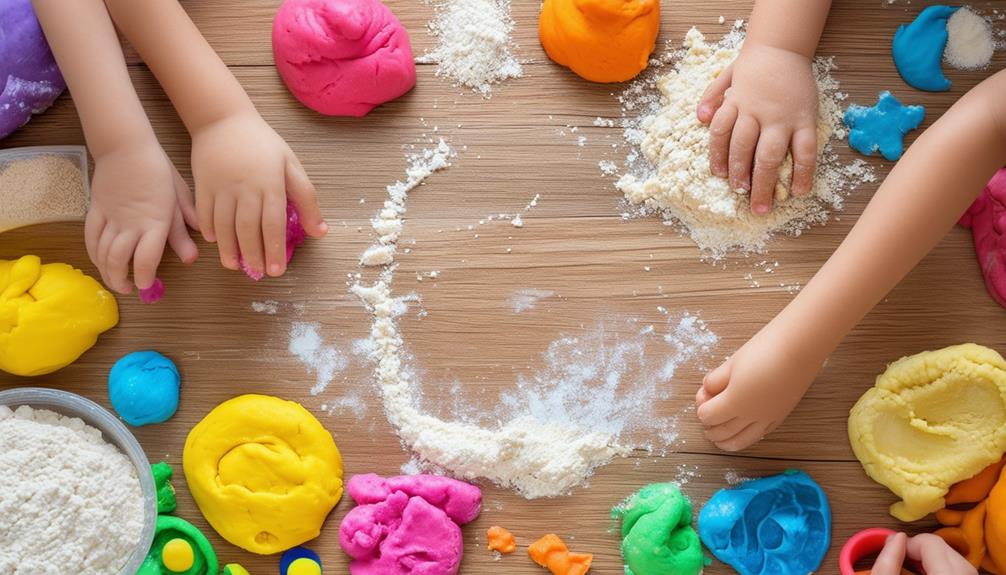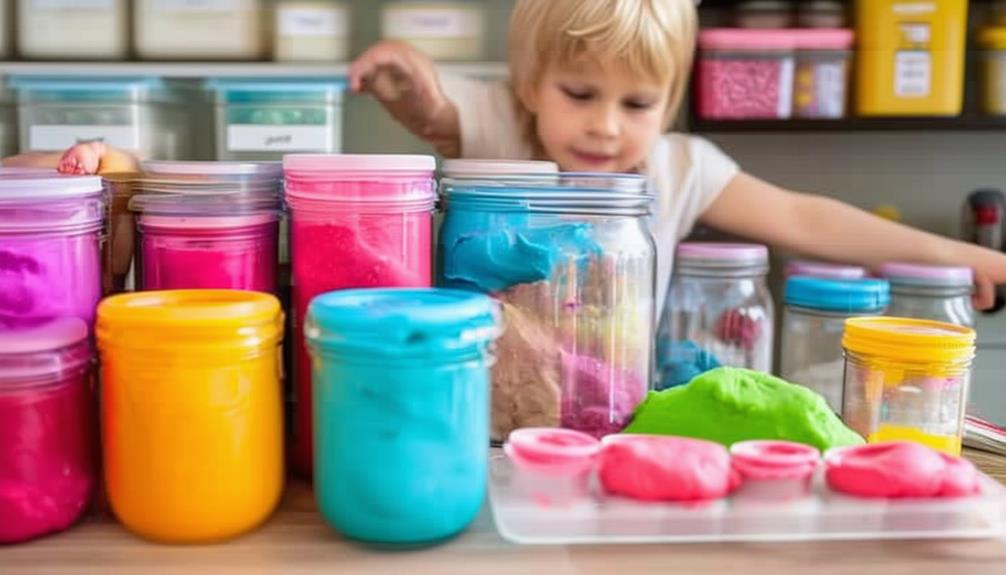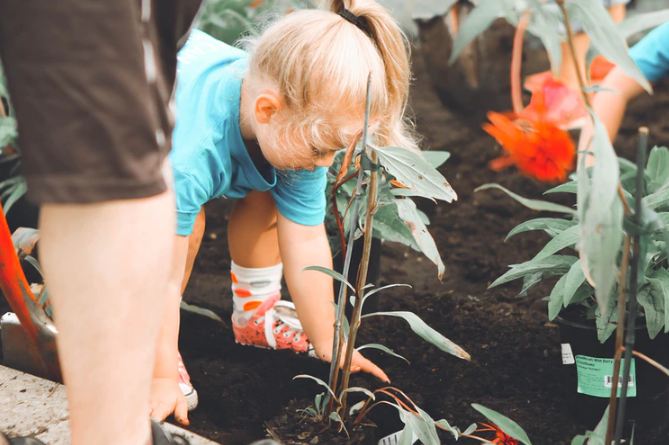Playdough Recipe for Kids With Allergies

Creating playdough that is safe for kids with allergies requires using alternative ingredients to avoid common allergens like gluten, dairy, and nuts. Consider using rice flour or gluten-free flour and natural food coloring derived from fruits and vegetables. This approach ensures a more inclusive and enjoyable experience for all children. Achieving the right texture and consistency without the usual ingredients can be challenging, but let's explore the essential steps and tips to make allergen-friendly playdough that kids will love.
Allergy-Friendly Ingredients
When making playdough for kids with allergies, it's crucial to use safe ingredients like rice flour or gluten-free flour. Traditional playdough often contains wheat and dairy, which can trigger reactions in children with specific dietary restrictions. By opting for allergy-safe ingredients, you can create a secure and enjoyable experience for all children.
Replace wheat flour with rice flour or gluten-free flour to ensure the playdough is free from common allergens. Additionally, use natural food coloring derived from fruits and vegetables instead of synthetic dyes to make it safer for kids with sensitivities.
Avoid any food allergens like dairy or nuts to keep the playdough non-toxic. Many online resources offer recipes tailored to various allergies, ensuring that every child's needs are met. Using these allergy-safe ingredients allows you to create fun, colorful playdough that all kids can enjoy without the risk of allergic reactions. Incorporating allergy-safe ingredients in your playdough not only ensures safety but also promotes inclusivity, allowing every child to participate in creative play.
Step-by-Step Instructions
To make your allergy-friendly playdough, start by mixing 1/4 cup of margarine with 1/3 cup of corn syrup, 1/2 teaspoon of salt, and 1 teaspoon of vanilla extract. This combination ensures the playdough is nut-free and dairy-free, making it suitable for children with these allergies. Gradually add 2-3 cups of powdered sugar until the mixture reaches a playdough-like consistency.
Once the dough is ready, divide it into several sections. Add a few drops of food coloring to each section and knead until the color is evenly distributed. This step is excellent for engaging kids and promoting fine motor skills.
- Gluten-free: Safe for kids with gluten allergies
- Kid-approved: Fun colors and textures
- Easy and allergy-friendly: Perfect for playdates and classrooms
The result is a playdough similar in texture to traditional playdough, providing hours of fun without any worries. Ensure you knead the dough thoroughly to mix the colors well.
Storage Tips

To keep your allergy-friendly playdough fresh and extend its longevity, store it in an airtight container. Place the container in a cool, dry spot away from direct sunlight. This simple step will ensure your children can enjoy the playdough multiple times.
Airtight Container Benefits
An airtight container's primary advantage is keeping your playdough fresh and preventing it from drying out. By storing playdough in an airtight container, you create a sealed environment that shields it from air, moisture, and contaminants. This simple storage solution helps maintain the playdough's softness and pliability, ensuring it's ready for play whenever your child wants to use it.
Preserving the freshness with an airtight container extends the playdough's longevity. This means you won't need to make or buy new playdough as frequently, saving you time and effort. Airtight containers also help preserve the color and scent of the playdough, keeping it vibrant and appealing.
Key benefits of using an airtight container for playdough storage include:
- Maintains texture and softness: Prevents the playdough from drying out and becoming crumbly.
- Protects from contaminants: Keeps out dust, dirt, and other unwanted particles.
- Extends playdough lifespan: Ensures your playdough stays usable for a longer period.
Incorporating airtight containers into your playdough storage routine is a straightforward way to improve preservation and optimize the fun for your kids.
Longevity and Freshness
Proper storage techniques are crucial for keeping playdough fresh and soft. For natural gluten-free playdough, using an airtight glass container at room temperature can maintain its ideal freshness for over a year.
Here are some tips to maintain the quality of your gluten-free playdough:
| Tip | Details |
|---|---|
| Keep Airtight | Store in airtight glass containers at room temperature. |
| Revive | Knead or add a small amount of coconut oil if it starts to dry out. |
| Check for Freshness | Look for signs like drying out, cracking, and crumbling to determine if it's old. |
| Make a New Batch | Prepare a new batch if the playdough shows signs of deterioration. |
If your playdough starts to dry out, you can revive it by kneading it or adding a small amount of coconut oil. However, if you notice signs of deterioration such as drying out, cracking, or crumbling, it's time to make a new batch. This ensures that your playdough remains fresh and soft for your kids to enjoy. Proper storage and timely revival are key to extending the usability of your gluten-free playdough.
Variations and Substitutions
You can personalize playdough for kids with allergies by making several variations and substitutions. For a gluten-free version, substitute rice flour for wheat flour. If your child has dairy allergies, use coconut oil instead of butter to keep the playdough soft and malleable.
Natural food coloring is another excellent option. Ingredients like beet juice or turmeric provide vibrant colors without artificial dyes, which can sometimes trigger allergies. Adding aromatic oils not only introduces a pleasant scent but also ensures the playdough remains free from synthetic fragrances, making it ideal for sensitive kids.
To enrich the sensory experience, experiment with different types of salt. For example, Himalayan pink salt can add a unique texture and slight color variation to the playdough, making it even more captivating for children.
- Substitute rice flour for wheat flour to make it gluten-free.
- Use coconut oil instead of butter for dairy-free playdough.
- Opt for natural food coloring like beet juice or turmeric for a dye-free option.
Benefits of Homemade Playdough

Crafting homemade playdough allows you to customize it according to your child's specific allergy needs, ensuring a safer and more enjoyable sensory experience. This DIY approach guarantees the playdough is free from common allergens like wheat and dairy, making it suitable for children with various dietary restrictions. By using alternatives such as rice flour or gluten-free flour, you can create a fun and inclusive playtime environment.
One significant advantage of homemade playdough is the control over its ingredients. You can choose natural food coloring to avoid synthetic additives that might trigger allergies, ensuring the playdough remains safe. This allows your child to enjoy a vibrant and engaging play experience without the risk of an allergic reaction.
Additionally, making playdough at home offers a secure and imaginative bonding activity. Numerous online resources provide easy-to-follow recipes for allergy-friendly playdough, making the process simple and enjoyable. By creating your own playdough, you ensure a safe sensory experience tailored specifically to your child's needs, giving you peace of mind and offering your child fun, allergy-free playtime.
Common Allergy Concerns
When making playdough for kids with allergies, be aware of common allergens such as wheat and dairy. Check ingredient labels to ensure all components are safe. By addressing these concerns, you can create a fun and safe play experience for your child.
Labeling Regulations Importance
In today's world, labeling regulations are crucial for helping individuals with allergies identify potential allergens in food products. If your child has food allergies, you understand the importance of clear allergen labeling on every item you buy. Strict labeling laws are designed to prevent unintentional exposure to allergens like peanuts, tree nuts, milk, eggs, soy, wheat, fish, and shellfish.
Mandatory allergen listings on food packaging enable informed decisions, ensuring your child's safety. Countries such as Australia, the UK, Ireland, Canada, and the United States have implemented stringent regulations to ensure allergen labeling is clear and accessible.
Here's why these regulations matter:
- Transparency: Labels provide a clear list of potential allergens, keeping you fully informed about the product's contents.
- Safety: Rigorous labeling laws reduce the risk of accidental exposure to harmful allergens.
- Convenience: Mandatory allergen listings make grocery shopping less stressful, offering peace of mind.
These regulations are essential for ensuring that everyone, especially those with food allergies, can safely navigate their dietary choices.
Common Allergens Overview
Many common allergens found in traditional playdough, such as wheat and dairy, can pose significant risks for children with allergies. Kids with these sensitivities might experience adverse reactions when exposed to conventional playdough ingredients. To ensure playtime is both safe and enjoyable, it is essential to consider allergy-friendly alternatives.
Traditional playdough contains wheat flour, a major concern for children with gluten allergies. Dairy, often added for texture, is another potential trigger. Fortunately, there are numerous allergy-friendly recipes available that substitute these allergens with safer options.
| Common Allergens | Allergy-Friendly Alternatives |
|---|---|
| Wheat | Rice flour, gluten-free flour |
| Dairy | Coconut milk, almond milk |
| Synthetic dyes | Natural food coloring |
| Preservatives | Homemade mixtures |
| Fragrances | Essential oils |
Using these alternatives ensures a safer play environment for children with allergies, allowing them to enjoy the benefits of playdough without the associated health risks.




